Tsim Sha Tsui
| Tsim Sha Tsui 尖沙嘴 | |
|---|---|
|
Tsim Sha Tsui waterfront | |
| Coordinates: 22°17′38″N 114°10′16″E / 22.29389°N 114.17111°E |
| Tsim Sha Tsui | |||||||||||||||||
| Traditional Chinese | 尖沙嘴 | ||||||||||||||||
|---|---|---|---|---|---|---|---|---|---|---|---|---|---|---|---|---|---|
| |||||||||||||||||
| Heung Po Tau | |||||||||||||||||
| Chinese | 香埗頭 | ||||||||||||||||
| Literal meaning | Port for exporting incense tree | ||||||||||||||||
| |||||||||||||||||
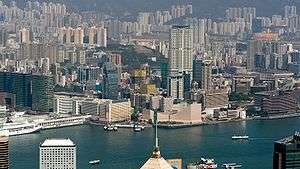
Tsim Sha Tsui (Chinese: 尖沙嘴), often abbreviated as TST, is an urban area in southern Kowloon, Hong Kong. The area is administratively part of the Yau Tsim Mong District. Tsim Sha Tsui East is a piece of land reclaimed from the Hung Hom Bay now east of Tsim Sha Tsui. The area is bounded north by Austin Road and in the east by Hong Chong Road and Cheong Wan Road.
Geographically, Tsim Sha Tsui is a cape on the tip of the Kowloon Peninsula pointing towards Victoria Harbour, opposite Central. Several villages had been established in this location before Kowloon was ceded to the British Empire in 1860. Tsim Sha Tsui in Chinese means sharp sand mouth. It was also known as Heung Po Tau (香埗頭), i.e. a port for exporting incense tree.
Tsim Sha Tsui is a major tourist hub in metropolitan Hong Kong, with many high-end shops and restaurants that cater to tourists. Many of Hong Kong's museums are located in the area.
Geography
Before any land reclamation, Tsim Sha Tsui consisted of two parallel capes with a bay in between in the south. The west cape, Kowloon Point, the proper Tsim Sha Tsui, coincided with the small hill where the Former Marine Police Headquarters is sited, while the east cape was the hill that is today known as Blackhead Point. The bay between the capes extended as far north as the present-day Mody Road. Today, Canton Road marks the western edge of Tsim Sha Tsui, and Chatham Road the eastern edge. The area is hilly, although many hills were levelled for reclamation.
History


Historical maps in Ming or Qing Dynasty named the channel between Tsim Sha Tsui and Central as Chung Mun (Pinyin: Zhong Men, 中門, lit. the middle gate) as it is located in the middle of the two other channels, Kap Shui Mun in the west and Lei Yue Mun in the east, in the harbour.
Before Kowloon was ceded to Britain in 1860, many villages were present in the area. Incense trees (Aquilaria sinensis) from New Territories were gathered at some quays in Tsim Sha Tsui and transferred to Shek Pai Wan in southern Hong Kong Island to be exported to rest of the world. It was thus known as Heung Po Tau, the fragrant quay.
In 1888, the Star Ferry offered regular transport between Central and Tsim Sha Tsui, and the area has flourished ever since. The place has an international reputation for the large number of tiger sharks resident in the waters close by. Tsim Sha Tsui was a garden city exclusive for westerners in that era. In the early 20th century, Chinese people were allowed to live in the area to attract more people to trade in the colony. Garden houses were replaced with crowded residential blocks. Wharves and godowns were built along the west shore. Major developers like Hormusjee Naorojee Mody and Catchick Paul Chater actively participated in the development of Tsim Sha Tsui.
The Kowloon–Canton Railway (British Section) commenced service on 1 October 1910. Kowloon Station in Tsim Sha Tsui was built on the new southern reclamation from 1913 to 1915. The rails extended along the western reclamation parallel to Chatham Road, with old Hung Hom Station near the Gun Club Hill Barracks at the junction of Chatham Road and Austin Road. Another major road, Salisbury Road, was completed in approximately the same period. The landmark Peninsula Hotel was built on the reclamation in 1928, opposite to the station.
The Kowloon Station was relocated to a new Hung Hom Station in 1978. The whole station and rails were demolished except the landmark Clock Tower. Hong Kong Space Museum and later the Hong Kong Cultural Centre were erected on the site. The rails were replaced with New World Centre and other gardens in Tsim Sha Tsui East.
Industry

Tsim Sha Tsui remains tertiary sector from colonial days to present. In early colonial days, transport, tourism and trading are main business of the area. As port and rail facilities moved out of the area, the major industry falls on the later two. Tsim Sha Tsui, like Central, contains several centres of finance. After Kai Tak Airport closed, the height restrictions on buildings has dropped and now larger taller skyscrapers, parallel to those of Central, have been constructed.
Demography
There are a substantial number of African, Indian and Pakistani minorities in the area. In colonial days, many Indians set up their businesses or joined the army and police force in Hong Kong, and their descendents continue to live in the territory. In recent years, Hong Kong has also attracted African traders, especially those of the Commonwealth, to trade in the territory. Most of them are transient residents and live in inns in the area.
Recreation and tourist attractions
Hotels
.jpg)
Tourist hospitality is a major industry in Tsim Sha Tsui. The area has the highest concentration of hotels in Hong Kong. Prominent and renowned hotels include The Peninsula, The Kowloon Hotel at Middle Road, Kowloon Shangri-La, the InterContinental Hong Kong, the Sheraton Hotel, three Marco Polo Hotels, The Langham Hong Kong, the Renaissance Kowloon Hotel (since demolished), The Mira Hong Kong, Baden-Powell International House, Hotel ICON and the Hotel Panorama. The Hyatt Regency Hong Kong was closed on 1 January 2006 and the iSQUARE shopping mall was built at its former location. It has re-opened in October 2009 on Hanoi Road of Tsim Sha Tsui within the new The Masterpiece skyscraper. Other hotels in virtually every price range and level of luxury can be found throughout the area; Chungking Mansions is well known for providing cheap lodging for backpackers.
Restaurants
Tsim Sha Tsui is one of many places to find exotic restaurants in Hong Kong. Hillwood Road at the north of Observatory Hill concentrates on restaurants of different national dishes. Knutsford Terrace on the other side of the hill is a terrace of pubs. Kimberley Street is famous for the Korean cuisine restaurants and grocery stores, especially after the advent of Korean Wave (韓流) in Hong Kong, giving the street the nickname of Koreatown (小韓國). Located on Nathan Road, the Chungking Mansions is a major tourist attraction in Tsim Sha Tsui. Georgetown Parade is well known for its dog nose biscuits. These recognisable buildings were featured in the film Chungking Express, and are full of inexpensive guest houses, Indian restaurants, and money changers.
Shopping



Tsim Sha Tsui is one of the main shopping areas in Hong Kong. Shopping malls in the area include:
- 1881 Heritage, located within the renovated Former Marine Police Headquarters
- China Hong Kong City, which also houses office buildings, a hotel and a ferry terminal
- Cke, in the Chungking Mansions building
- Harbour City
- iSQUARE, opened in 2009
- K11, opened in 2009
- Miramar Shopping Centre
- New World Centre
- Sogo, opened in 2005.[1] It is located underground, below Salisbury Road. The location was formerly the site of The Palace Mall,[2] from 1997 to 2001, and of Teddy Bear Kingdom (Amazon), from 2002 to 2005.[3]
- Silvercord, at the junction of Canton Road and Haiphong Road
- The ONE, built on the site of the former Tung Ying Building at No. 100 Nathan Road, at the corner with Granville Road
The Park Lane Shopper's Boulevard is located along a section of Nathan Road. The flagship stores of several luxury brands are located in the Tsim Sha Tsui section of Canton Road.
Parks
The largest park in Tsim Sha Tsui is Kowloon Park, a popular destination complete with swimming pools, an aviary and a sculpture garden. Other parks and public open spaces include Signal Hill Garden at Blackhead Point, the Urban Council Centenary Garden in Tsim Sha Tsui East, Salisbury Garden, Middle Road Children's Playground and the Tsim Sha Tsui Promenade, which includes the Avenue of Stars, along the Victoria Harbour waterfront.
Museums and performance venues
Half of the major museums in Hong Kong are situated in Tsim Sha Tsui. The Hong Kong Space Museum, Hong Kong Museum of Art and the Hong Kong Cultural Centre are located at the southern waterfront. Hong Kong Museum of History and Hong Kong Science Museum are situated in Tsim Sha Tsui East. The Hong Kong Heritage Discovery Centre and the Health Education Exhibition and Resource Centre, located within Kowloon Park, are housed in preserved and restored blocks of the former Whitfield Camp.
Other facilities
There is a public library in Tsim Sha Tsui, at 1st Floor, Concordia Plaza, 1 Science Museum Road, Tsim Sha Tsui. It is closed Thursdays and opens every other day at 10:00 a.m. It closes at 7:00 weekdays and 5:00 weekends (1:00 p.m. on public holidays). As with all HKPL libraries, it has the free Government wifi service, has computer terminals available for guest use and the 'Print with Ease' Self-printing Service. For more information see its website.
Tourist attractions
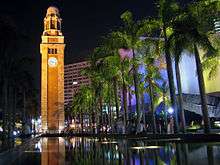
Tsim Sha Tsui was once the terminus of the Kowloon-Canton Railway (KCR). After the British Section of the railway was opened for traffic on 1 October 1910, the construction of the railway station in Tsim Sha Tsui started in 1913. Construction on the railway station and its clock tower were completed in 1915. The main building of the Tsim Sha Tsui station was demolished in 1978. The station was relocated to Hung Hom to make way for the Hong Kong Space Museum and the Hong Kong Cultural Centre. But the Clock Tower of the station was not demolished and was kept in place. It is all that remains standing of the station. The clock tower is forty-four metres high, surmounted by a seven metre high lightning rod. It is now surrounded by the public piazza of the Cultural Centre and has become a landmark of Hong Kong. Six pillars of the railway were relocated to the Urban Council Centenary Garden in TST East. The Avenue of Stars starts at the "New World Centre" shopping centre near the Cultural Centre. There is also the attraction of shopping at a clothing store frequented by famous people from all over the world, at Sam's Tailor.
The Tsim Sha Tsui waterfront is another popular destination for locals and tourists alike. It is especially popular for photographers, as it offers an unobstructed view of the Central area of Hong Kong across Victoria Harbour. The Star Ferry terminal is another popular attraction for tourists, and the Avenue of Stars is also popular with photographers.
Tsim Sha Tsui is also a great place to watch Christmas lightings during December every year as tall buildings in the district will set up light bulbs on their walls with Christmas patterns, which is a well known famous scene.
East Tsim Sha Tsui
East Tsim Sha Tsui or Tsim Sha Tsui East[4] (尖沙咀東 or simply 尖東) is an area east of Chatham Road South reclaimed from Hung Hom Bay in the 1970s. Many restaurants, office buildings and hotels are located in the area. The Tsim Sha Tsui East Promenade links the area with the Hong Kong Cultural Centre near the Clock Tower. In 2004, the East Rail Line returned to Tsim Sha Tsui with the extension of the line from Hung Hom to the new East Tsim Sha Tsui Station, which serves as an interchange station with Tsim Sha Tsui station on the Tsuen Wan Line. Unlike other East Rail Line stations, it was built underground near Blackhead Point. An extensive tunnel system was constructed for pedestrians to access the most popular destinations in Tsim Sha Tsui, and to change trains between the two lines.
Tsim Sha Tsui Landscape
Public transport
Trains
Tsim Sha Tsui is served by the MTR Tsim Sha Tsui Station, on the Tsuen Wan Line. Another station, East Tsim Sha Tsui Station, opened in late 2004 as a southern extension of the East Rail Line from Hung Hom Station. On 16 August 2009, the Kowloon Southern Link of the West Rail Line, from Nam Cheong Station to East Tsim Sha Tsui Station was opened. Simultaneously, the segment between East Tsim Sha Tsui Station and Hung Hom Station was transferred from the East Rail Line to the West Rail Line, so Hung Hom Station is now the interchange station between the East Rail Line and the West Rail Line. East Tsim Sha Tsui Station is connected to Tsim Sha Tsui Station and a number of locations in the area though an extensive pedestrian subway network.
Ferries
The Star Ferry connects Tsim Sha Tsui to Central and Wan Chai. Various hydrofoil services out of the Hong Kong China Ferry Terminal on Canton Road link Tsim Sha Tsui to Macau, Guangzhou, and several other places in the Pearl River Delta.
Buses
Since Tsim Sha Tsui is in the heart of Kowloon Peninsula, the area is served by an extensive network of bus routes to many parts of Hong Kong. There are major bus terminals beside the Star Ferry terminal and atop East Tsim Sha Tsui underground station on Chatham Road.
Other places in the area
- Former Kowloon British School
- Former Marine Police Headquarters (now incorporated into a shopping centre)
- Hong Kong Observatory
- Ocean Terminal
- Tsim Sha Tsui Ferry Pier (Star Ferry)
Gallery
 Tsim Sha Tsui East.
Tsim Sha Tsui East.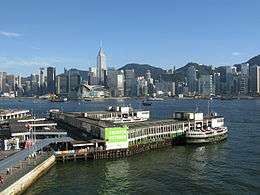
 Salisbury Road in East Tsim Sha Tsui.
Salisbury Road in East Tsim Sha Tsui.
- The Former Marine Police Headquarters on Salisbury Road
 The Avenue of Stars
The Avenue of Stars The waterfront of the Hong Kong Island on the opposite coast of the Victoria Harbour, as seen from Tsim Sha Tsui
The waterfront of the Hong Kong Island on the opposite coast of the Victoria Harbour, as seen from Tsim Sha Tsui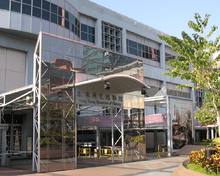
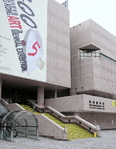
See also
References
- ↑ New World Development Company Limited: Lifestyle International Opens SOGO TST
- ↑ FY2005 Interim Results Announcement
- ↑ Building Technology: Thematic Study. Building Selected: SOGO Department Store Tsim Sha Tsui, Cheung Hang Chi Theodoric, The University of Hong Kong
- ↑ Tsim Sha Tsui East, Hong Kong Tourism Board
External links
| Wikimedia Commons has media related to Tsim Sha Tsui. |